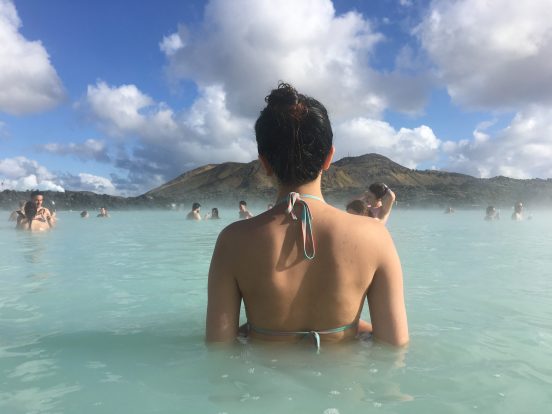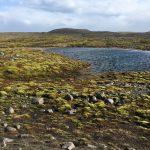In our travels, we visited several hot springs and public baths around the country. They have varied from small family-owned business such as Grettislaug, to commercially successful Blue Lagoon. However, there are indications that the increasing tourism has put pressure on some of these businesses. Around Reykjavik, we would often see signs for tourists to instruct how the locker rooms function. Though this activity provides tourist a glimpse into Icelander’s daily life, it begs me to question the cultural and social significance of this seemingly long practiced tradition. Through examining this space from a social geography perspective, I want to understand this cultural practice better.

According to Lefebvre, a socio-spatial dialectic is the notion that humans modify urban spaces to satisfy their own needs, while being conditioned by that very space the way they behave (Lefebvre, 1974). He theorized a conceptual triad that encompasses three different types of spatial relations. Firstly there is a space for spatial practices, where we practice our everyday routine. Secondly, here are representations of space, used by bureaucrats and developers on how the space should be conceived. For example, zoning is a practice that the government use to inform us the purpose of space. Thirdly, there are representational spaces, that are used by the public to express their opinion. To illustrate his theories, I will use Wreck beach as an example Wreck beach is a clothing optional beach. This condition was created by humans, which offers a sense of freedom other beaches can’t provide. Hence, this shows how the space we created are affecting our decisions on what activities should be conducted here. Applying his theories to this discussion, the spatial practice of geothermal pools is a public social space. It is a unique practice not only traceable to Iceland’s history since settlement, but also aid in fostering relationships between people that would be absent in other cultures.
Before modernization in Iceland, geothermal pools were in the form of natural hot springs such as Grettislaug. Inthe sagas, one of the earliest record was in Laxdæla Saga, whereGuðrún often bathed in Guðrúnarlaug (Grettis Saga, 1900).This was dated to the 1000AD. Other than the historical significance of this activity, there has been nationwide effort to make geothermal pools accessible to the public as well. Before 1900, less than 1% of the population knew how to swim. Nowadays, it is mandatory to learn to swim in the Icelandic education curriculum. Thus, it is deeply integrated into Icelander’s daily routine before or after work to relax and socialize in their neighborhood geothermal pool.

If we assess this space using Lefebvre’s triad, geothermal pools in Iceland is a spatial practice that reinforces equality in the country. Lefebvre argued that spatial relations are always mediated through power relations. However, this public facility is easily accessible to the public. The low poverty rate in Iceland ensure pricing for accessing geothermal pools to be affordable for most people. This is mostly the case for public swimming facilities such as Sundhöllin. On the other hand, for privately owned locations such as Grettislaug, it serves as a representation of space rather than a place for spatial practice. The remote seaside location and stories associated creates a romantic notion for this type of facility. Hence, this type of geothermal pool is more significant on what it stands for, rather than the function it serves. To that end of the spectrum, Blue Lagoon signifies not only the geothermal bathing culture in Iceland, but the apparent boom of wealth from tourism. It is expected to provide the ultimate bathing experience.
Throughout the past 100 years, this practice of geothermal pool bathing has evolved. The facilities modernized and are made publicly accessible. Hence, it shifted the nature of this space from private to public. Commercializing this practice such as Blue Lagoon had made geothermal pools attractive to tourists as well. Through studying the socio-spatial dialectic of geothermal pools, I’ve come to understand how modernization has shaped an everyday routine in Iceland.
Bibliography
Masso, Anu. “ABOUT THE LINGUISTIC CONSTITUTION OF SOCIAL SPACE: THE …” Accessed June 17, 2018. http://www.bing.com/cr?IG=0FEC2EA84A4040CF9E6900DDC4628311&CID=181219D8710F61A3383215C970F26058&rd=1&h=n9b2Fj5eaTXYVPkhXKVJjhlr62jIMnHXj8KnRN-_4CM&v=1&r=http://www.kirj.ee/public/trames_pdf/2008/issue_2/Trames-2008-2-151-182.pdf&p=DevEx.LB.1,5526.1.
Johannag. “Hvað Kostar í Sund?” Reykjavíkurborg. December 31, 2017. Accessed June 17, 2018. https://reykjavik.is/gjaldskrar/hvad-kostar-i-sund.
Kühne, Olaf. “The Genesis of Social Landscapes and Their Physical Manifestations.” Landscape and Power in Geographical Space as a Social-Aesthetic Construct, 2018, 49-78. doi:10.1007/978-3-319-72902-2_3.
Lefebvre, Henri, and Donald Nicholson-Smith. The Production of Space. Malden, MA: Blackwell, 1974.
Ragnarsdóttir, Regína Hrönn. “Guðrúnarlaug Hot-tub – the Saga Hot-tub in West-Iceland.” Guide to Iceland. May 30, 2013. Accessed June 17, 2018. https://guidetoiceland.is/connect-with-locals/regina/hot-tubs-in-iceland—gurunarlaug.
Ásmundarson, Vald. Grettis Saga: Buid Hefir Til Prentunar Vald. Asmundarson. Reykjavik, 1900. Accessed June 17, 2018.
ÓLADÓTTIR, ODDNÝ ÞÓRA. “Tourism in Iceland in Figures.” Ferðamálastofa. April 2015. Accessed June 17, 2018. https://www.ferdamalastofa.is/en/recearch-and-statistics/tourism-in-iceland-in-figures.

